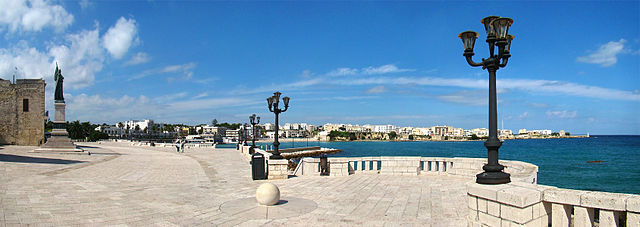Otranto, also known as the “Martyrs’ Town”, is the true gem of Salento, a bridge between the West and East, a territory full of Caribbean beaches, a place rich in history, art and culture. Walking in the streets of Otranto is an emotion that is rarely forgotten. The alleyways, the monuments and the ancient beauty of the old town give it an unparalleled charm that can capture the look and heart of every visitor. The historic center welcomes tourists from all over the world who love to get lost in the historical riches that it offers: the Cathedral cones the historic historical riches, the Aragonese Castle, the city wall.
Immediately go to the eye as Otranto is a fortified city, whose ancient village is enclosed by the defensive walls that allow Porta Alfonso’s access to its interior. Geographic location has always represented a double-cut weapon, an opportunity but also a threat to the city: it was often the scene of invasions and conflicts aimed at the occupation of the area, which for a long time represented the shopping center Of Salento.
Everything begins when Greek settlers build the village, expanding to what would then be known as Magna Grecia. Over the centuries, Otranto was conquered by the Longobards, the Byzantines, the Angevins, the Aragonese and the Turks, and then ended up under the reign of Venice and even in the French hands. A long series of peoples and predominants alternated in the control of the city, which inevitably still preserves the signs of these passages today; It is reflected in the artistic treasures, in the culture, in the architectural works that have come to our day.
The Aragonese Castle is the defensive stronghold of the city of Otranto, nowadays a casket of culture and knowledge that abounds in events and exhibitions of an international character.
Damaged, repaired and reconstructed, the fort has seen changes since the siege of 1067, but it was after the historic buccaneer attack of 1480 that the defensive structure was expanded and equipped with cannons towers.
The cathedral, built on the remains of a Messapic village, a Roman domus and an early Christian temple, was founded in 1068 by the Norman bishop William. It is a synthesis of several architectural styles including Byzantine, early Christian and Romanesque elements.
Of great scenic impact is the wide pavement floor decoration that develops along the aisles, the presbytery and the apse. It was commissioned by the first Latin Archbishop of the city, Gionata, and was executed between 1163 and 1165 by a group of artists led by Pantaleone (mosaic) Pantaleone, a Basilian monk of the monastery of San Nicola di Casole.
Walking through the majestic walls you can appreciate various architectural details such as the Alfonsina towers, Duchess and Ippolita, the diamante Punta di Bastione, and the Triangular Hall with innovative defensive techniques that make it one of the most important examples of military architecture of the ‘era.
But Otranto is also famous for the immaculate beaches among these, especially the Alimini Beach, surrounded by unspoilt dunes, among the fragrances typical of Mediterranean scrub and immaculate sand. The Bay of the Turks, an impressive white sandy language surrounded by rich Mediterranean vegetation and Porto Badisco, a dreamy cove where, according to legend, Anea landed during his escape from Troy.

